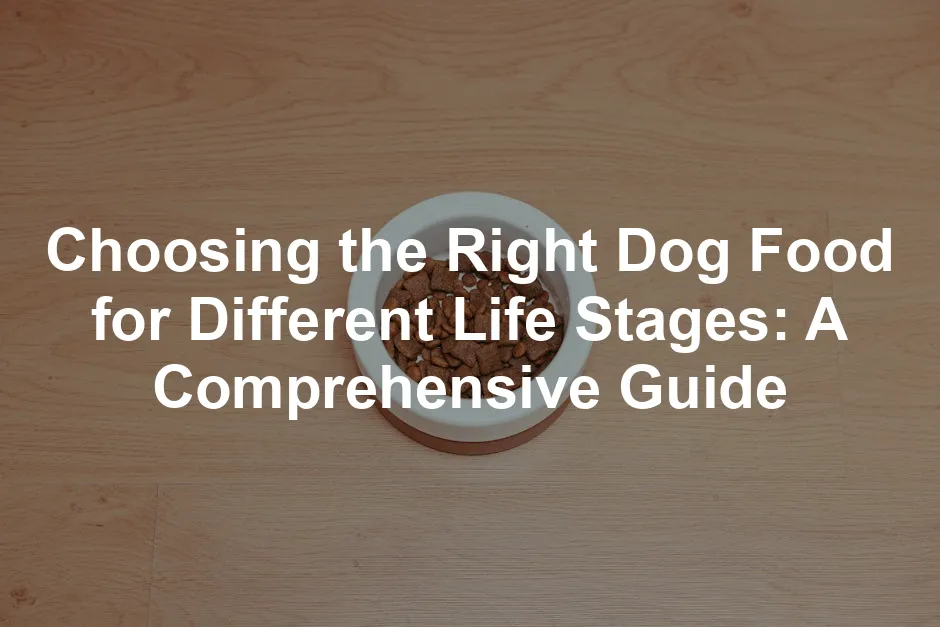Introduction
Navigating the pet food aisle can feel like stepping into a labyrinth designed by a master of confusion. With countless options claiming to be the “best,” how do you choose the perfect meal for your furry friend? Just like humans, dogs undergo various life stages, each with unique nutritional requirements. Whether you have a playful puppy, a robust adult, or a wise senior, selecting the right dog food is crucial for their health and happiness.
Puppies need food packed with protein and calories to fuel their growth. Adult dogs require balanced meals to maintain energy and health. Senior dogs, on the other hand, often need lower-calorie options and ingredients that support joint health. Understanding these differences is vital.
In this guide, we’ll unravel the complexities of canine nutrition, helping you make informed decisions to nourish your four-legged companion throughout their life. With expert insights and practical tips, you’ll be ready to tackle the pet food puzzle head-on. So, grab your shopping list and let’s make sure your pup gets the nutrition they deserve!

Summary of Key Points
In this article, we’ll explore the importance of choosing age-appropriate dog food and how nutritional needs evolve from puppyhood to seniority. Here’s a sneak peek into what we’ll cover:
- Understanding Life Stages: Dogs transition through distinct life stages—puppy, adult, and senior—each requiring specific nutrients for optimal health.
- Nutritional Components: Discover the essential macronutrients—proteins, fats, and carbohydrates—that should be included in your dog’s diet, tailored to their life stage.
- How to Read Labels: Learn the intricacies of dog food labels, including AAFCO guidelines and what to look for in ingredients.
- Special Dietary Needs: Address specific health issues such as allergies, joint health, and weight management, and how to select appropriate diets.
- Consulting Your Veterinarian: Understand the value of professional advice in choosing the best food for your dog’s unique needs.
By the end of this guide, you’ll be equipped with the knowledge to select the right dog food that supports your pet’s health and well-being at every stage of life. Proper nutrition is not just about filling a bowl; it’s about nurturing a lifelong companion. With the right food, your dog will be ready to tackle any adventure—whether it’s a game of fetch or a cozy nap in the sun!

Understanding Dog Food and Nutrition
Choosing the right dog food is no walk in the park. Just like humans, dogs have specific nutritional needs that evolve over their lifetime. Understanding these needs is the first step to ensuring your furry friend stays healthy and happy.
Dog Nutritional Needs
Puppies, adults, and seniors each require different nutrients to thrive. Puppies are like little energy balls, needing a diet rich in proteins, fats, and essential nutrients. A high protein content (around 22-32%) fuels their rapid growth. Fats are crucial too, providing energy and supporting brain development. Ingredients like DHA (Docosahexaenoic Acid) promote brain health, while calcium and phosphorus are vital for bone growth.
Adult dogs, however, are all about balance. They need a mix of protein (18-25%), fats (10-15%), and carbohydrates to maintain their energy levels and overall health. This is where moderation comes in. Too much protein can lead to obesity, especially if they’re couch potatoes. For a great option, consider Hill’s Science Diet Adult Dog Food. It’s formulated to provide the right balance of nutrients for your adult dog.
As dogs age, their dietary needs shift again. Senior dogs benefit from lower calories to prevent weight gain, along with higher fiber to aid digestion. Joint health becomes a priority, so look for food with glucosamine and chondroitin to support those aging joints. A well-rounded diet at this stage can also help keep their immune system strong.

What Makes a Dog Food “Good”?
Not all dog food is created equal. Quality dog food should be complete and balanced, meeting the standards set by the Association of American Feed Control Officials (AAFCO). This means it contains all the essential nutrients required for your dog’s specific life stage.
Look for whole ingredients, like real meat, grains, and vegetables, rather than fillers. Fillers might sound like a good idea, but they offer little nutritional value. Ingredients should be easily digestible and suited to your dog’s dietary needs. After all, your pup deserves more than just a bowl of “meh.” For a great choice, try Blue Buffalo Life Protection Formula Natural Adult Dry Dog Food, which is packed with quality ingredients to keep your dog healthy.

Life Stages of Dogs
Puppies
Puppies are bundles of joy and energy, but they also come with specific dietary needs. Their food should be packed with higher protein (about 22-32%) and fat (around 8-20%). Essential nutrients like DHA are crucial for brain development, ensuring your puppy grows up to be a smart cookie. For the best start, consider Blue Buffalo Wilderness Puppy Chicken Recipe. It’s specially formulated for growing pups.
When it comes to feeding guidelines, consider your puppy’s breed size. Small breed puppies typically mature around 10-12 months, while medium breeds take about a year. Large breeds require special attention; they should consume large-breed puppy food to prevent rapid growth that can lead to skeletal issues. Aim for 3-4 meals a day as they grow, then ease into 2-3 meals as they mature.

Adult Dogs
Adult dogs need a balanced diet to maintain their health and energy levels. They thrive on moderate protein (18-25%) and healthy fats (10-15%). These nutrients help keep their weight in check and provide the energy necessary for daily activities. A great option for adult dogs is Purina Pro Plan Savor Adult Dry Dog Food, which offers a perfect blend of nutrients for your active dog.
Consider your dog’s breed size and activity level when choosing food. Very active breeds might need a higher calorie count, while less active ones should stick to lower-calorie options to avoid obesity. A well-balanced diet helps your adult dog stay fit and lively, ready to chase after that elusive squirrel.

Senior Dogs
As dogs age, their nutritional needs change once again. Senior dogs often require lower calories to prevent weight gain, along with a focus on joint support. Look for food that includes glucosamine and chondroitin to help with mobility. To learn more about choosing the right food for senior dogs, check out our Guide to choosing the right dog food for senior dogs.
Choosing the right food is essential for senior dogs to maintain their health. Guide to choosing the right dog food for senior dogs
Digestibility becomes more important for seniors, so opt for highly digestible foods that are easy on their stomachs. Additionally, fiber plays a key role in gastrointestinal health. The right diet can make all the difference in keeping your aging pup happy and spry, ready to enjoy their golden years.
By understanding these life stages and their unique dietary requirements, you can ensure your furry friend receives the nutrition they need at every stage of life. Happy feeding!

How to Read a Dog Food Label
Understanding dog food labels can feel like deciphering a secret code. Thankfully, the FDA has made it easier by requiring specific information on every bag and can. Here are the eight key components you need to know:
- Product Name: This tells you what’s in the food. For instance, “Chicken Dinner” means chicken is the main ingredient.
- Net Weight: This is the total weight of the food inside the package. Just a friendly reminder—check how much you’re getting!
- Manufacturer’s Name and Address: This helps you know where the food is made. Transparency is key!
- Guaranteed Analysis: This is where the magic happens. It provides minimum nutrient levels like protein and fat. Look out for these numbers to ensure your dog gets a balanced diet.
- List of Ingredients: Ingredients are listed by weight. The first few should be high-quality proteins, not fillers.
- Intended Animal Species: This label makes clear whether the food is for dogs or cats. Spoiler alert: dogs and cats have different dietary needs.
- Statement of Nutritional Adequacy: This indicates if the food meets AAFCO standards for your dog’s life stage. If it says, “complete and balanced,” you’re on the right track!
- Feeding Guidelines: These indicate how much to feed based on your dog’s weight and age. It’s always a good idea to adjust based on your dog’s individual needs.
Taking a closer look at the guaranteed analysis and ingredient list is crucial. The guaranteed analysis shows the minimum levels of important nutrients, while the ingredient list helps you judge the quality of the food. High-quality ingredients like real meat and whole grains should be prioritized.

But beware of clever marketing! Terms like “premium” or “natural” don’t always mean the food is better for your pup. Always look at the actual ingredients and nutritional content. Your dog deserves the best, and understanding these labels is the first step in ensuring they get it.
Ingredient Insights
When it comes to ingredients, the first few items on the list matter most. Aim for real meat, like chicken or beef, to be listed as the first ingredient. These are excellent protein sources that support your dog’s growth and energy needs. Whole grains like brown rice or oats are also great. They provide fiber and energy without the empty calories that fillers offer.
However, beware of misleading marketing claims. Just because a bag says “made with real meat” doesn’t mean it’s the main ingredient. Oftentimes, food manufacturers play tricks with ingredient placement by splitting similar ingredients, like “chicken meal” and “chicken fat,” to make it appear that there’s more meat in the product than there really is. Always read the label carefully. A well-informed pet parent is the best advocate for their furry friend!

Special Dietary Needs
Dogs, just like humans, can have special dietary needs influenced by allergies, age, or medical conditions. Understanding these unique requirements helps ensure their well-being.
Allergies and Sensitivities
Identifying common allergens is crucial for keeping your pup healthy. Some dogs react negatively to ingredients like beef, chicken, dairy, or grains. If you suspect your dog has food allergies, consider transitioning to a hypoallergenic diet. These foods typically contain limited ingredients, making it easier to pinpoint what might be causing issues. For more information on managing food allergies, refer to our article on understanding and managing dog food allergies.
Managing allergies in dogs is essential for their health. Understanding and managing dog food allergies
Look for products labeled as “grain-free” or “limited ingredient.” These diets often have fewer potential allergens, which can help reduce reactions. Again, it’s wise to consult your veterinarian for tailored advice, especially if your dog has ongoing issues or sensitivities.

Joint Health and Weight Management
As dogs age or if they are prone to obesity, nutritional strategies can be a game changer. Weight management is essential for maintaining overall health. Look for dog food labeled for weight control, as these contain fewer calories but still provide essential nutrients. A solid choice is Wellness CORE Grain-Free Large Breed Dog Food, which supports healthy weight while providing essential nutrients.
For dogs with arthritis or joint pain, ingredients like glucosamine and chondroitin can be helpful. These supplements support joint health and mobility, making it easier for your dog to stay active.

Medical Conditions
Consulting with your veterinarian is invaluable when managing a dog’s specific health issues. Conditions like kidney disease or diabetes require tailored dietary advice. Your vet might recommend prescription diets designed to meet these unique needs. Remember, what works for one dog may not work for another. Each dog is unique, and their dietary needs should reflect that!
Proper nutrition is vital at every stage of a dog’s life. By understanding how to read labels and recognizing special dietary needs, you can make informed decisions that promote your dog’s health and happiness. After all, a well-fed dog is a happy dog!

Conclusion
Choosing the right dog food is a vital aspect of responsible pet ownership. It ensures your furry friend thrives through all life stages. Each stage—puppy, adult, and senior—comes with its own unique nutritional needs. Puppies need high protein for growth, while adults require balanced meals to maintain energy levels. Senior dogs often benefit from lower calories and added joint support.
With a solid understanding of these nutritional needs, you contribute significantly to their health and happiness. It’s not just about satisfying their hunger; it’s about nourishing them for the adventures ahead. Proper nutrition leads to a longer, happier life for your dog.
Remember, your veterinarian is an invaluable resource in this journey. They can help navigate the maze of dietary options to find the perfect fit for your beloved pet. So, take the time to consult with them. Your dog deserves the best, and together, you can make informed decisions that support their well-being.
In the end, a well-fed dog is a happy dog. With the right food, your furry friend will be ready to tackle any challenge—be it a game of fetch or a cozy cuddle session on the couch. Prioritize their nutrition, and watch them flourish!

FAQs
What should I feed my puppy?
Puppies need nutrient-dense food rich in proteins and fats. Look for specialized puppy formulas that support growth.
When should I switch my dog to adult food?
Generally, small breeds mature around 10-12 months, medium breeds by 12 months, and large breeds between 12-18 months. Consult your vet for specifics.
What are the signs of good quality dog food?
Look for a “complete and balanced” label per AAFCO standards, high-quality ingredients, and a nutritional adequacy statement.
Can I feed my dog homemade food?
Yes, but consult a veterinary nutritionist to ensure it meets all nutritional needs. Avoid toxic ingredients like chocolate or grapes.
How do I transition my dog to new food?
Gradually mix the new food with the old one over a week. Start with a small amount of new food and gradually increase it to avoid digestive issues.
Please let us know what you think about our content by leaving a comment down below!
Thank you for reading till here 🙂
All images from Pexels





